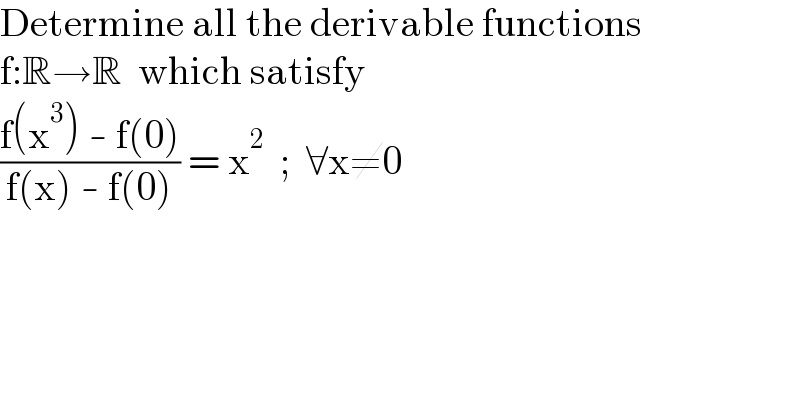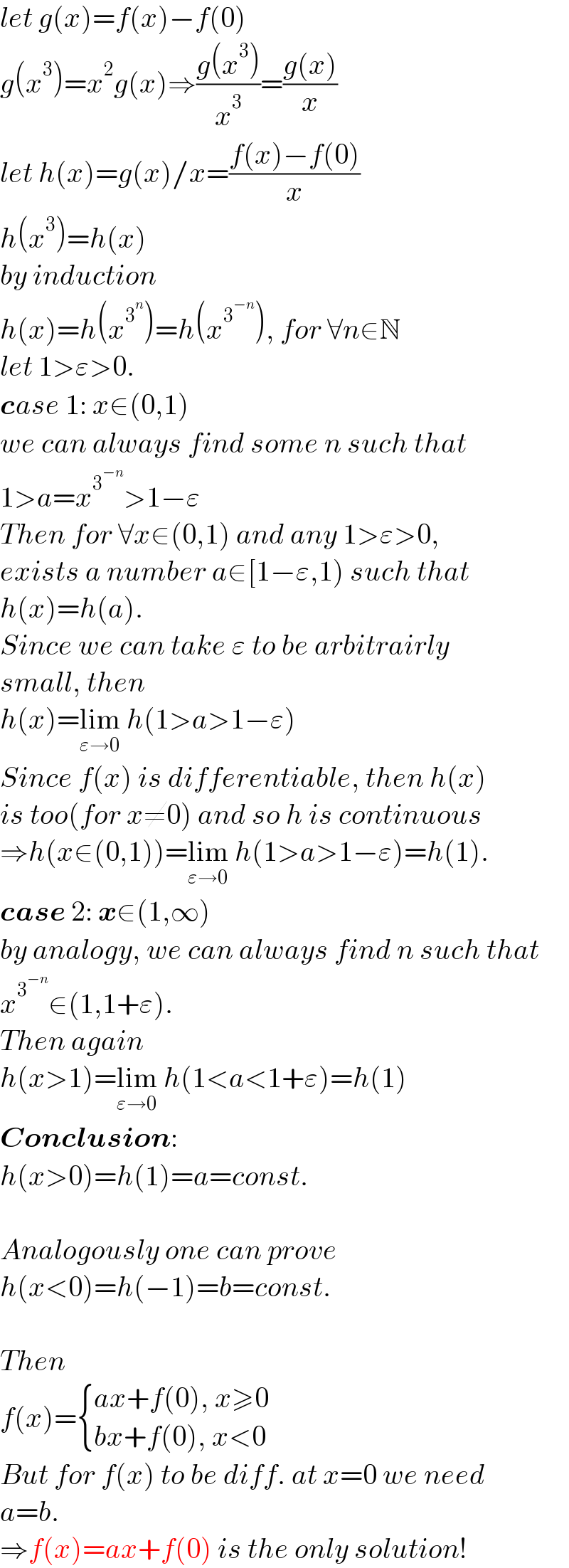
Question Number 153162 by mathdanisur last updated on 05/Sep/21

$$\mathrm{Determine}\:\mathrm{all}\:\mathrm{the}\:\mathrm{derivable}\:\mathrm{functions} \\ $$$$\mathrm{f}:\mathbb{R}\rightarrow\mathbb{R}\:\:\mathrm{which}\:\mathrm{satisfy} \\ $$$$\frac{\mathrm{f}\left(\mathrm{x}^{\mathrm{3}} \right)\:-\:\mathrm{f}\left(\mathrm{0}\right)}{\mathrm{f}\left(\mathrm{x}\right)\:-\:\mathrm{f}\left(\mathrm{0}\right)}\:=\:\mathrm{x}^{\mathrm{2}} \:\:;\:\:\forall\mathrm{x}\neq\mathrm{0} \\ $$
Answered by aleks041103 last updated on 05/Sep/21

$${let}\:{g}\left({x}\right)={f}\left({x}\right)−{f}\left(\mathrm{0}\right) \\ $$$${g}\left({x}^{\mathrm{3}} \right)={x}^{\mathrm{2}} {g}\left({x}\right)\Rightarrow\frac{{g}\left({x}^{\mathrm{3}} \right)}{{x}^{\mathrm{3}} }=\frac{{g}\left({x}\right)}{{x}} \\ $$$${let}\:{h}\left({x}\right)={g}\left({x}\right)/{x}=\frac{{f}\left({x}\right)−{f}\left(\mathrm{0}\right)}{{x}} \\ $$$${h}\left({x}^{\mathrm{3}} \right)={h}\left({x}\right) \\ $$$${by}\:{induction} \\ $$$${h}\left({x}\right)={h}\left({x}^{\mathrm{3}^{{n}} } \right)={h}\left({x}^{\mathrm{3}^{−{n}} } \right),\:{for}\:\forall{n}\in\mathbb{N} \\ $$$${let}\:\mathrm{1}>\varepsilon>\mathrm{0}. \\ $$$$\boldsymbol{{c}}{ase}\:\mathrm{1}:\:{x}\in\left(\mathrm{0},\mathrm{1}\right) \\ $$$${we}\:{can}\:{always}\:{find}\:{some}\:{n}\:{such}\:{that} \\ $$$$\mathrm{1}>{a}={x}^{\mathrm{3}^{−{n}} } >\mathrm{1}−\varepsilon \\ $$$${Then}\:{for}\:\forall{x}\in\left(\mathrm{0},\mathrm{1}\right)\:{and}\:{any}\:\mathrm{1}>\varepsilon>\mathrm{0},\: \\ $$$${exists}\:{a}\:{number}\:{a}\in\left[\mathrm{1}−\varepsilon,\mathrm{1}\right)\:{such}\:{that} \\ $$$${h}\left({x}\right)={h}\left({a}\right). \\ $$$${Since}\:{we}\:{can}\:{take}\:\varepsilon\:{to}\:{be}\:{arbitrairly} \\ $$$${small},\:{then} \\ $$$${h}\left({x}\right)=\underset{\varepsilon\rightarrow\mathrm{0}} {\mathrm{lim}}\:{h}\left(\mathrm{1}>{a}>\mathrm{1}−\varepsilon\right) \\ $$$${Since}\:{f}\left({x}\right)\:{is}\:{differentiable},\:{then}\:{h}\left({x}\right) \\ $$$${is}\:{too}\left({for}\:{x}\neq\mathrm{0}\right)\:{and}\:{so}\:{h}\:{is}\:{continuous} \\ $$$$\Rightarrow{h}\left({x}\in\left(\mathrm{0},\mathrm{1}\right)\right)=\underset{\varepsilon\rightarrow\mathrm{0}} {\mathrm{lim}}\:{h}\left(\mathrm{1}>{a}>\mathrm{1}−\varepsilon\right)={h}\left(\mathrm{1}\right). \\ $$$$\boldsymbol{{case}}\:\mathrm{2}:\:\boldsymbol{{x}}\in\left(\mathrm{1},\infty\right) \\ $$$${by}\:{analogy},\:{we}\:{can}\:{always}\:{find}\:{n}\:{such}\:{that} \\ $$$${x}^{\mathrm{3}^{−{n}} } \in\left(\mathrm{1},\mathrm{1}+\varepsilon\right). \\ $$$${Then}\:{again} \\ $$$${h}\left({x}>\mathrm{1}\right)=\underset{\varepsilon\rightarrow\mathrm{0}} {\mathrm{lim}}\:{h}\left(\mathrm{1}<{a}<\mathrm{1}+\varepsilon\right)={h}\left(\mathrm{1}\right) \\ $$$$\boldsymbol{{Conclusion}}: \\ $$$${h}\left({x}>\mathrm{0}\right)={h}\left(\mathrm{1}\right)={a}={const}. \\ $$$$ \\ $$$${Analogously}\:{one}\:{can}\:{prove} \\ $$$${h}\left({x}<\mathrm{0}\right)={h}\left(−\mathrm{1}\right)={b}={const}. \\ $$$$ \\ $$$${Then} \\ $$$${f}\left({x}\right)=\begin{cases}{{ax}+{f}\left(\mathrm{0}\right),\:{x}\geqslant\mathrm{0}}\\{{bx}+{f}\left(\mathrm{0}\right),\:{x}<\mathrm{0}}\end{cases} \\ $$$${But}\:{for}\:{f}\left({x}\right)\:{to}\:{be}\:{diff}.\:{at}\:{x}=\mathrm{0}\:{we}\:{need} \\ $$$${a}={b}. \\ $$$$\Rightarrow{f}\left({x}\right)={ax}+{f}\left(\mathrm{0}\right)\:{is}\:{the}\:{only}\:{solution}! \\ $$
Commented by mathdanisur last updated on 06/Sep/21

$$\mathrm{Thank}\:\mathrm{you}\:\mathrm{ser}\:\mathrm{nice} \\ $$
